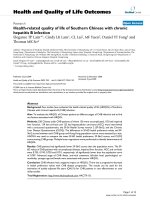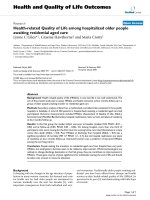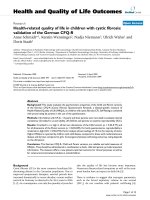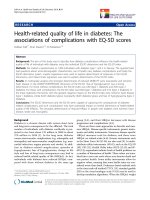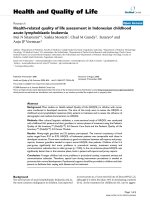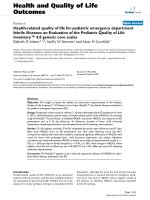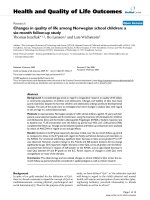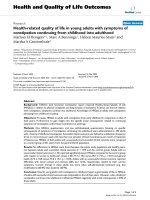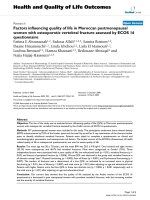báo cáo hóa học:" Women''''s quality of life is decreased by acute cystitis and antibiotic adverse effects associated with treatment" pptx
Bạn đang xem bản rút gọn của tài liệu. Xem và tải ngay bản đầy đủ của tài liệu tại đây (243.88 KB, 7 trang )
BioMed Central
Page 1 of 7
(page number not for citation purposes)
Health and Quality of Life Outcomes
Open Access
Research
Women's quality of life is decreased by acute cystitis and antibiotic
adverse effects associated with treatment
Erika J Ernst*
1
, Michael E Ernst
†1,2
, James D Hoehns
†1,4
and
George R Bergus
†2,3
Address:
1
College of Pharmacy, University of Iowa, Iowa City, IA, USA,
2
Department of Family Medicine, University of Iowa Health Care, Iowa
City, IA, USA,
3
Carver College of Medicine, University of Iowa, Iowa City, IA, USA and
4
Northeast Iowa Medical Education Foundation, Waterloo,
IA, USA
Email: Erika J Ernst* - ; Michael E Ernst - ; James D Hoehns - ;
George R Bergus -
* Corresponding author †Equal contributors
Abstract
Background: Although acute cystitis is a common infection in women, the impact of this infection and its treatment on
women's quality of life (QOL) has not been previously described.
Objectives: To evaluate QOL in women treated for acute cystitis, and describe the relationship between QOL, clinical
outcome and adverse events of each of the interventions used in the study.
Methods: Design. Randomized, open-label, multicenter, treatment study.
Setting. Two family medicine outpatient clinics in Iowa.
Patients. One-hundred-fifty-seven women with clinical signs and symptoms of acute uncomplicated cystitis.
Intervention. Fifty-two patients received trimethoprim/sulfamethoxazole 1 double-strength tablet twice daily for 3 days,
54 patients received ciprofloxacin 250 mg twice daily for 3 days and 51 patients received nitrofurantoin 100 mg twice
daily for 7 days.
Measurements. QOL was assessed at the time of enrollment and at 3, 7, 14 and 28 days after the initial visit. QOL was
measured using a modified Quality of Well-Being scale, a validated, multi-attribute health scale. Clinical outcome was
assessed by telephone interview on days 3, 7, 14 and 28 using a standardized questionnaire to assess resolution of
symptoms, compliance with the prescribed regimen, and occurrence of adverse events.
Results: Patients experiencing a clinical cure had significantly better QOL at days 3 (p = 0.03), 7 (p < 0.001), and 14 (p
= 0.02) compared to patients who failed treatment. While there was no difference in QOL by treatment assignment,
patients experiencing an adverse event had lower QOL throughout the study period. Patients treated with ciprofloxacin
appeared to experience adverse events at a higher rate (62%) compared to those treated with TMP/SMX (45%) and
nitrofurantoin (49%), however the difference was not statistically significant (p = 0.2).
Conclusion: Patients experiencing cystitis have an increase in their QOL with treatment. Those experiencing clinical
cure have greater improvement in QOL compared to patients fail therapy. While QOL is improved by treatment, those
reporting adverse events have lower overall QOL compared to those who do not experience adverse events. This study
is important in that it suggests that both cystitis and antibiotic treatment can affect QOL in a measurable way.
Published: 27 July 2005
Health and Quality of Life Outcomes 2005, 3:45 doi:10.1186/1477-7525-3-
45
Received: 28 April 2005
Accepted: 27 July 2005
This article is available from: />© 2005 Ernst et al; licensee BioMed Central Ltd.
This is an Open Access article distributed under the terms of the Creative Commons Attribution License ( />),
which permits unrestricted use, distribution, and reproduction in any medium, provided the original work is properly cited.
Health and Quality of Life Outcomes 2005, 3:45 />Page 2 of 7
(page number not for citation purposes)
Background
Acute uncomplicated cystitis is a common community
acquired infection in women, causing an estimated 7 mil-
lion episodes yearly in the United States [1]. On average,
each episode is associated with 1.2 days of missed work or
classes [1]. The cost of treating ambulatory patients with
symptoms of dysuria is estimated to exceed 1 billion dol-
lars per year in the United States [1].
As with the majority of infectious diseases, empiric ther-
apy is the cornerstone of treatment for acute uncompli-
cated cystitis. When obtained, urine cultures often take
several days for results, making it necessary to begin ther-
apy empirically. Selection of the antibiotic must take into
consideration many factors, including results of clinical
trials demonstrating efficacy of a chosen regimen, known
susceptibility patterns of commonly infecting organisms,
the clinical condition of the patient, as well as drug aller-
gies, rate of adverse reactions and cost of treatment. In
many settings, particularly health maintenance organiza-
tions, treatment algorithms exist for the empiric treatment
of acute cystitis [2,3]. In most cases, these guidelines sug-
gest treatment based upon symptoms of disease in other-
wise healthy adult women and recommend against
obtaining culture and sensitivity tests [2]. At least one
study has shown this treatment strategy to be the most
cost-effective means of therapy [4].
In order to fully compare potential antimicrobial regi-
mens, factors such as clinical cure rates, complications,
including adverse events of treatment, and quality of life
(QOL) should be taken into account. While there are sev-
eral tools available in the literature to evaluate QOL, the
majority are applied to patients with chronic diseases such
as rheumatoid arthritis or with cancer [5]. One pilot study
has been published evaluating QOL in acute cystitis and
found that it is significantly affected by the illness [6].
However, the impact of treatment on QOL has not been
evaluated in the previously published study.
Additionally, the evaluation of adverse effects related to
different treatments and the impact on QOL have not
been described previously for cystitis. Most of the pub-
lished literature comparing the impact of treatment on a
patients' QOL is limited to chronic diseases or treatments
with severe adverse effects such as cancer chemotherapy
[7-10]. We sought to determine the impact of a common
infection, cystitis, on QOL and evaluate the impact of
three different treatment regimens on QOL in these
patients. The addition of QOL information could be use-
ful to primary care physicians when deciding on an anti-
biotic for empiric treatment of cystitis.
Methods
Patients were recruited from two outpatient family medi-
cine clinics in the state of Iowa, both affiliated with the
University of Iowa College of Medicine and College of
Pharmacy. Women aged 18 to 65 were eligible for inclu-
sion in the study if they had clinical symptoms of cystitis,
including dysuria or frequency, and were considered by
their primary physician to have acute uncomplicated cys-
titis and were not allergic to any study medication.
Patients were excluded if they had diabetes, known ana-
tomical abnormalities, urinary symptoms for greater than
7 days, vaginal discharge, or were pregnant. These exclu-
sion criteria were intended to select for acute cystitis
patients and exclude patients who may have pyelonephri-
tis or sexually transmitted diseases. All study procedures
were approved by the Institutional Review Board at the
University of Iowa.
After obtaining written informed consent, patients pro-
vided a urine specimen for culture and sensitivity. Patients
were then randomized, using a random number genera-
tor, to one of three treatments; a) Trimethoprim/Sulfame-
thoxazole (TMP/SMX) 800 mg/160 mg (Qualitest
Pharmaceuticals, Inc, Huntsville, AL) 1 tablet twice daily
for 3 days, b) ciprofloxacin 250 mg (Cipro, Bayer Corpo-
ration, West Haven CT) 1 tablet twice daily for 3 days or
c) nitrofurantoin 100 mg (Macrobid, Proctor & Gamble
Pharmaceuticals, Cincinnati, OH) 1 capsule twice daily
for 7 days. Nitrofurantoin was given for seven days
because clinical studies have shown it to be less effective
in a three day regimen compared to TMP/SMX [11]. Med-
ication was provided to the patient by a pharmacist on the
research team.
Outcome was assessed by telephone interview using a
standardized questionnaire to assess resolution of symp-
toms, compliance with the prescribed regimen, and occur-
rence of adverse events. Patients were questioned using a
prompted list of symptoms and also asked if they experi-
enced any adverse or side effects from the prescribed regi-
men. QOL was measured using the Quality of Well-Being,
a validated, multi-attribute health scale [12]. This scale
was selected because it has been successfully applied to
acute illnesses, whereas other quality of life scales, such as
the SF-36 Health Survey, are better suited to assess chronic
illnesses [4]. Higher scores on the Quality of Well-Being
reflect higher QOL. The questionnaire was modified
slightly to be administered over the telephone and was re-
administered by a trained interviewer at each follow up
contact. Four follow-up telephone contacts were necessary
to evaluate early and late recurrence of cystitis, and were
completed at 3, 7, 14 and 28 days after the initial visit.
Clinical cure was defined as the absence of symptoms and
no additional antibiotic treatment for urinary symptoms
Health and Quality of Life Outcomes 2005, 3:45 />Page 3 of 7
(page number not for citation purposes)
within the 28 day follow up period. Therefore, if a woman
reported continued symptoms at day 7 but did not receive
additional antibiotic treatment and had resolution of
symptoms on follow up at days 14 and 28, she was con-
sidered a clinical cure. These criteria were selected with the
purpose of mimicking usual care. Urine culture results
were classified as positive (greater that 50,000 colony
forming units per milliliter), negative (less than 50,000
colony forming units per milliliter) or contaminated
(containing multiple organisms at less than 50,000 col-
ony forming units per milliliter).
The two tailed t-test for independent samples was used to
compare QOL by outcome and adverse events. One-way
analysis of variance with the Bonferroni correction was
used to compare QOL by culture results (positive, nega-
tive, contaminated) or drug treatment (TMP/SMZ, Cipro-
floxacin, Nitrofurantoin). Differences in cure rates
between treatments were compared using the chi square
test. Fisher's exact test was used to compare outcome and
organism susceptibility. We estimate power of 75% to
detect significant differences in QOL, adverse events and
outcome at the alpha level of 0.05.
Results
Patient enrolment and demographics
One-hundred-fifty-seven patients met the inclusion crite-
ria and were enrolled in the study. Eleven patients were
excluded from the analysis of outcome and adverse
events. Of these 11, nine were lost to follow up, one had
her symptoms resolve before she took the medication and
one was scheduled for surgery and her surgeon wanted her
to receive a different medication. One patient experienced
severe nausea after one day and was prescribed another
antibiotic. This patient was counted as experiencing an
adverse event and a clinical failure. See figure 1 for the dia-
gram of patient enrollment.
The mean age of women enrolled in the study was 34
years (range 18–69). There were no significant differences
in baseline demographic between the randomized groups
(Table 1). Of the 157 women enrolled, 57% had positive
urine cultures, 26% had negative cultures, and 17% had
contaminated specimens. E. coli accounted for 82% of the
positive urine cultures (Table 2). Of all organisms iso-
lated, resistance to TMP/SMZ, ciprofloxacin and nitro-
furantoin were 7%, 1% and 8%, respectively. For E. coli
the resistance rates were 7%, 0% and 4% for TMP/SMX,
ciprofloxacin and nitrofurantoin, respectively.
Clinical outcomes
Clinical cure rates did not differ by treatment with 88, 82
and 87% of patients treated with TMP/SMX, ciprofloxacin
and nitrofurantoin, respectively experiencing a clinical
cure (p = 0.7). Patients randomized to TMP/SMX who
were infected with a resistant organism had lower cure
rates, compared to those infected with a susceptible
organism (50% vs. 83%), although this difference was not
statistically significant due to the low number of infec-
tions with resistant organisms (Table 3). Patients treated
with ciprofloxacin appeared to experience adverse events
at a higher rate (62%) compared to those treated with
TMP/SMX (45%) and nitrofurantoin (49%); however, the
difference was also not statistically significant (p = 0.2).
Quality of life outcomes
Overall, the QOL of patients treated for acute uncompli-
cated cystitis improved over the study period. Quality of
Well Being scores improved for all patients, from a mean
(± SD) of 0.68 (± 0.03) at baseline to 0.81 (± 0.11) at day
28 (Figure 2). Patients experiencing a clinical cure had sig-
nificantly better QOL at days 3 (0.77 vs. 0.72, p = 0.04), 7
(0.82 vs. 0.71, p < 0.001), and 14 (0.83 vs. 0.76, p = 0.01)
compared to patients who failed treatment (Figure 3).
QOL at baseline was not different between patients suc-
cessfully treated compared to those who failed therapy
(0.68 vs. 0.68, p = 0.6) or day 28 (0.82 vs. 0.79, p = 0.5).
There was a statistically significant difference in QOL by
culture result (p = 0.004). In the post hoc analysis,
patients with positive urine cultures had significantly
higher quality of well being scores compared to patients
with negative urine cultures (0.69 versus 0.66, p = 0.003)
but not compared to patients with contaminated urine
cultures (0.68, p = 0.23) at baseline. All three groups had
improvement in their QOL over the study period (Figure
4). There was no significant difference in improvement of
QOL by treatment assignment (Figure 5).
Adverse effects
Seventy-six of the 146 patients included in the analysis
reported 94 adverse events. Gastrointestinal effects and
vaginitis were the most commonly occurring adverse
events, accounting for 26 (28%) and 25 (27%) of the
effects, respectively. Headache (12% of patients) and
other central nervous system effects such as dizziness
(5%) were the next most common side effects. The
remaining 12% of adverse events were a variety of miscel-
laneous complaints. Patients experiencing an adverse
event had significantly lower QOL compared to those not
experiencing an adverse event throughout the study
period, including differences at baseline (Figure 6).
Discussion
We have described the impact of a seemingly minor infec-
tion, acute uncomplicated cystitis, on the QOL of women.
Our study is the first to examine the effect of successful
treatment compared to treatment failure on the QOL. Fur-
ther, we have also shown that experiencing an adverse
effect from treatment also directly impacts QOL. While
the three antibiotics used in this study differed in terms of
Health and Quality of Life Outcomes 2005, 3:45 />Page 4 of 7
(page number not for citation purposes)
Diagram of patient enrolment and analysisFigure 1
Diagram of patient enrolment and analysis.
Table 1: Patient Demographics
All Patients TMP/SMZ Ciprofloxacin Nitrofurantoin
Age in years (mean ± SD) 34 ± 12 33 ± 12 32 ± 12 36 ± 12
Weight in kg (mean ± SD) 73 ± 21 73 ± 22 72 ± 22 74 ± 22
Overweight, >20% of ideal body weight (%) 26 29 22 31
Number of concomitant medications (mean ± SD, range) 1 ± 2, 0–12 1 ± 2 1 ± 2 1 ± 2
Received antibiotics in previous 6 months (%) 34 35 30 38
Receiving oral contraceptives or hormone replacement therapy (%) 39 33 48 35
Sexually active (%) 85 89 85 80
Urinary tract infection in previous 6 months (%) 37 40 43 28
157 patients enrolled
52 randomized to
TMP /SMZ.
2 lost to follow-up
and 1 had
symptoms resolve
before receiving
treatment.
54 randomized to
Ciprofloxacin.
4 lost to follow-up
51 randomized
to Nitrofurantoin
3 lost to follow-
up and 1
scheduled for
surgery ;surgeon
request different
treatment
146 analyzed
for outcome
and adverse
events
Health and Quality of Life Outcomes 2005, 3:45 />Page 5 of 7
(page number not for citation purposes)
cure rates and adverse effects we found little difference in
the impact on QOL between treatments.
Current recommendations suggesting empiric therapy
with TMP/SMX without obtaining cultures may need to be
modified in the era of increasing resistance [1,3,4,13].
However, altering empiric therapy recommendations to
either nitrofurantoin or fluoroquinolone antibiotics,
without information on local resistance patterns, may
result in unnecessary increases in health care expenditures
due to increased drug costs. In primary care offices, where
limiting the inappropriate prescribing of antimicrobial
Table 2: Organism species and susceptibility results of culture specimens from women with acute uncomplicated cystitis
N % % susceptible TMP/
SMX
Ciprofloxacin Nitrofurantoin
E. coli 73 82 93 100 95
P. mirabillis 55.6100100na
K. pneumonia 44.410010050
S. aureus 3 3.3 100 0 100
C. koseri 2 2.2 100 100 100
B-hemolytic Strep 1 1.1 na na na
S. saphophyticus 1 1.1 0 100 100
Total 89 100
na = not available
Table 3: Percent (no.) of patients successfully treated by organism susceptibility
Susceptible Resistant p value
TMP/SMZ 83% (43/52) 50% (1/2) 0.9
Ciprofloxacin 76% (41/54)
Nitrofurantoin 80% (41/51) 100% (1/1) 0.6
Quality of Life for all patient at each follow up contactFigure 2
Quality of Life for all patient at each follow up contact.
Days after enrollment
0371428
Quality of Well Being Score
0.0
0.2
0.4
0.6
0.8
1.0
Quality of Life in patients by clinical outcome at each follow up contactFigure 3
Quality of Life in patients by clinical outcome at each follow
up contact.
Days after enrollment
0123456
Quality of Well Being Score
0.0
0.2
0.4
0.6
0.8
1.0
mean QWB cure
mean QWB fail
p = 0.6
p = 0.04
p = <0.001
p = 0.01
p = 0.5
Health and Quality of Life Outcomes 2005, 3:45 />Page 6 of 7
(page number not for citation purposes)
therapy is receiving focused attention by the Centers for
Disease Control and Prevention, information regarding
the emergence of resistance and clinical outcome is essen-
tial to providing evidence-based recommendations for
empiric antimicrobial therapy for acute uncomplicated
cystitis.
In our study, we found the resistance rate of E. coli to
TMP/SMX remained low, approximately 7% for women
with cystitis. We also found that clinical cure did not differ
between the treatment regimens tested. These findings are
important because it means TMP/SMX continues to be an
effective first line antibiotic in our population.
Our findings support those of a previously published
study, indicating that uncomplicated cystitis has a signifi-
cant, measurable impact on patients' QOL [6]. Patients'
QOL was improved throughout the study period (figure
2). QOL was significantly higher in patients experiencing
a clinical cure compared to those who failed treatment at
days 3, 7 and 14 (figure 3). QOL did not differ between
these groups at baseline and 28 days. This indicates all
patients were experiencing significant decreases in QOL at
baseline. It also indicates we are able to measure the
impact of cystitis on QOL. The fact that QOL was not dif-
ferent between patients experiencing a cure or failure of
initial therapy, reflects the success of alternate treatment
after experiencing the initial failure.
QOL at baseline was not different between patients with
positive or contaminated urine cultures. However, QOL
did differ significantly at baseline between patients with
positive and negative urine cultures. One possible expla-
nation for this difference is that patients with culture neg-
ative cystitis are more sensitive to the impact of cystitis
symptoms on their QOL compared to those with positive
urine cultures. That is to say that while their urine culture
was negative, the urinary symptoms they were experienc-
ing had a greater impact on QOL compared with patients
Quality of Life in patients by urine culture results at each fol-low up contactFigure 4
Quality of Life in patients by urine culture results at each fol-
low up contact.
Change in quality of life by drug treatment over the study periodFigure 5
Change in quality of life by drug treatment over the study
period.
Days after enrollment
0371428
Quality of Well Being Score
0.5
0.6
0.7
0.8
0.9
1.0
mean QWB cxpos
mean QWB cxneg
mean QWB cont
p = 0.004 p = 0.6
p = 0.4
p = 0.6 p = 0.6
Days after enrollment
0371428
Average Change in Quality of Well Being Score from Baseline
0.00
0.02
0.04
0.06
0.08
0.10
0.12
0.14
0.16
avechgiwbtmp
avechgiwbcipro
avechgiwbnitro
p = 0.06
p=0.6
p=0.6 p=0.9
Patient quality of life by adverse event experience at each fol-low up contactFigure 6
Patient quality of life by adverse event experience at each fol-
low up contact.
Days after enrollment
0371428
Mean Index of Well Being Score
0.0
0.2
0.4
0.6
0.8
1.0
1.2
no adverse event
yes adverse event
p = 0.02
p = 0.001
p = <0.001
p = 0.03 p = 0.04
Health and Quality of Life Outcomes 2005, 3:45 />Page 7 of 7
(page number not for citation purposes)
that have a higher overall QOL. Alternatively, patients
with culture negative cystitis may differ in some other way
that impacts their QOL compared to patients with culture
positive cystits.
We did not find any significant difference between the
drug treatments on patients' QOL throughout the study
period (figure 5). While there was a trend toward lower
QOL in the group of patients treated with TMP/SMZ at
day 3, this difference did not reach statistical significance
(p = 0.06). Therefore based upon improvements in QOL,
all three treatments may be considered appropriate empir-
ical therapy for cystitis.
Previously, the effect of medication adverse events on
QOL has only been demonstrated with more severe
adverse events such as those experienced with cancer
chemotherapy [14-16]. We have shown that even com-
mon side effects of antibiotics such as gastrointestinal
effects have a negative impact on patients QOL. While
some difference was observed in the rate of adverse events
reported between treatment groups, this difference did
not reach statistical significance. We also found that
patients reporting adverse events had lower QOL through-
out the study period, including baseline and at 28 days.
This may suggest that patients with lower overall QOL
may be more sensitive to the addition of drug therapy to
their daily routine. The potential for patients having lower
QOL reporting more adverse events has not been previ-
ously described. This information along with our findings
that patients with negative urine cultures also have lower
QOL suggests certain patients experience greater impacts
on their QOL from seemingly innocuous occurrences
such as urinary symptoms of cystitis or taking antibiotics
compared to other patients. It is possible that health care
providers may need to approach diagnosis and treatment
in these patients differently from other patients. More care
may be necessary in evaluating symptoms and laboratory
information to decide whether treatment is necessary and
more care may be needed in drug therapy selection, for
example.
Conclusion
In summary, we have found that patients experiencing
cystitis have significant decreases in QOL and that QOL is
improved by effective treatment. Furthermore we have
found that patients reporting adverse events have lower
overall QOL and may be impacted to a greater extent by
simple infections and adverse events associated with
treatment.
Authors' contributions
EJE conceived the study, participated in its design and
coordination, performed the statistical analysis and
drafted the manuscript. MEE participated in the study
design, coordination and patient recruitment and helped
revise the manuscript. JDH participated in patient
recruitment and helped revise the manuscript. GRB
participated in study design, data analysis and manuscript
revision. All authors read and approved the final
manuscript.
Acknowledgements
We would like to acknowledge the Society of Infectious Diseases Pharma-
cists Pfizer Research Award for the financial support of this study.
References
1. Hooton TM, Stamm WE: Diagnosis and treatment of uncompli-
cated urinary tract infection. Infect Dis Clin North Am 1997,
11:551-581.
2. Stamm WE, Hooton TM: Management of urinary tract infec-
tions in adults [see comments]. N Engl J Med 1993,
329:1328-1334.
3. Barry HC: Cost-effectiveness analysis [letter; comment]. J
Fam Pract 1997, 44:524; discussion 524-5.
4. Barry HC, Ebell MH, Hickner J: Evaluation of suspected urinary
tract infection in ambulatory women: a cost-utility analysis
of office-based strategies [see comments]. J Fam Pract 1997,
44:49-60.
5. Anderson JP, Kaplan RM, Coons SJ, Schneiderman LJ: Comparison
of the Quality of Well-being Scale and the SF-36 results
among two samples of ill adults: AIDS and other illnesses. J
Clin Epidemiol 1998, 51:755-762.
6. Ellis AK, Verma S: Quality of life in women with urinary tract
infections: is benign disease a misnomer? J Am Board Fam Pract
2000, 13:392-397.
7. Patients' Perceptions of Quality of Life After Treatment for
Early Prostate Cancer. J Clin Oncol 2003, 21:3777-3784.
8. Downs TM, Sadetsky N, Pasta DJ, Grossfeld GD, Kane CJ, Mehta SS,
Carroll PR, Lubeck DP: Health Related Quality of Life Patterns
in Patients Treated With Interstitial Prostate Brachyther-
apy for Localized Prostate Cancer-Data From CaPSURE. J
Urol 2003, 170:1822-1827.
9. Fukuhara S, Lopes AA, Bragg-Gresham JL, Kurokawa K, Mapes DL,
Akizawa T, Bommer J, Canaud BJ, Port FK, Held PJ, The F, Dopps W:
Health-related quality of life among dialysis patients on
three continents: The Dialysis Outcomes and Practice Pat-
terns Study. Kidney Int 2003, 64:1903-1910.
10. Zubarik R, Benway D, Moses P, Ferrentino N: Health-related qual-
ity of life (HRQOL) subsequent to esophageal adenocarci-
noma staging with endoscopic ultrasound (EUS). Am J
Gastroenterol 2003, 98:S218.
11. Hooton TM, Winter C, Tiu F, Stamm WE: Randomized compara-
tive trial and cost analysis of 3-day antimicrobial regimens
for treatment of acute cystitis in women [see comments].
Jama 1995, 273:41-45.
12. Kaplan RM, Bush JW, Berry CC: Health status: types of validity
and the index of well-being. Health Serv Res 1976, 11:478-507.
13. Carlson KJ, Mulley AG: Management of acute dysuria. A deci-
sion-analysis model of alternative strategies. Ann Intern Med
1985, 102:244-249.
14. Ballatori E, Roila F: Impact of Nausea and Vomiting on Quality
of Life in Cancer Patients During Chemotherapy. Health Qual
Life Outcomes 2003, 1:46.
15. Di Maio M, Perrone F: Quality of Life in elderly patients with
cancer. Health Qual Life Outcomes 2003, 1:44.
16. Gravis G, Bladou F, Salem N, Macquart-Moulin G, Serment G,
Camerlo J, Genre D, Bardou VJ, Maraninchi D, Viens P: Weekly
administration of docetaxel for symptomatic metastatic
hormone-refractory prostate carcinoma. Cancer 2003,
98:1627-1634.
